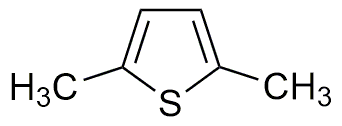2,5-Dimethylthiophene is widely utilized in research focused on:
- Flavor and Fragrance Industry: This compound is used to create unique scents and flavors in perfumes and food products, enhancing their appeal with its distinctive aroma.
- Organic Synthesis: It serves as an important building block in the synthesis of various organic compounds, making it valuable for researchers developing new materials or pharmaceuticals.
- Polymer Production: 2,5-Dimethylthiophene is employed in the production of conductive polymers, which are essential in electronics and energy applications, such as organic solar cells.
- Analytical Chemistry: It is used as a standard in gas chromatography, helping scientists accurately analyze complex mixtures in environmental and food safety testing.
- Research on Aromatic Compounds: This compound is studied for its properties and reactions, contributing to the understanding of thiophene derivatives and their applications in various chemical processes.
General Information
Properties
Safety and Regulations
Applications
2,5-Dimethylthiophene is widely utilized in research focused on:
- Flavor and Fragrance Industry: This compound is used to create unique scents and flavors in perfumes and food products, enhancing their appeal with its distinctive aroma.
- Organic Synthesis: It serves as an important building block in the synthesis of various organic compounds, making it valuable for researchers developing new materials or pharmaceuticals.
- Polymer Production: 2,5-Dimethylthiophene is employed in the production of conductive polymers, which are essential in electronics and energy applications, such as organic solar cells.
- Analytical Chemistry: It is used as a standard in gas chromatography, helping scientists accurately analyze complex mixtures in environmental and food safety testing.
- Research on Aromatic Compounds: This compound is studied for its properties and reactions, contributing to the understanding of thiophene derivatives and their applications in various chemical processes.
Documents
Safety Data Sheets (SDS)
The SDS provides comprehensive safety information on handling, storage, and disposal of the product.
Product Specification (PS)
The PS provides a comprehensive breakdown of the product’s properties, including chemical composition, physical state, purity, and storage requirements. It also details acceptable quality ranges and the product's intended applications.
Certificates of Analysis (COA)
Search for Certificates of Analysis (COA) by entering the products Lot Number. Lot and Batch Numbers can be found on a product’s label following the words ‘Lot’ or ‘Batch’.
Número de catálogo
Número de lote/lote
Certificates Of Origin (COO)
This COO confirms the country where the product was manufactured, and also details the materials and components used in it and whether it is derived from natural, synthetic, or other specific sources. This certificate may be required for customs, trade, and regulatory compliance.
Número de catálogo
Número de lote/lote
Safety Data Sheets (SDS)
The SDS provides comprehensive safety information on handling, storage, and disposal of the product.
DownloadProduct Specification (PS)
The PS provides a comprehensive breakdown of the product’s properties, including chemical composition, physical state, purity, and storage requirements. It also details acceptable quality ranges and the product's intended applications.
DownloadCertificates of Analysis (COA)
Search for Certificates of Analysis (COA) by entering the products Lot Number. Lot and Batch Numbers can be found on a product’s label following the words ‘Lot’ or ‘Batch’.
Número de catálogo
Número de lote/lote
Certificates Of Origin (COO)
This COO confirms the country where the product was manufactured, and also details the materials and components used in it and whether it is derived from natural, synthetic, or other specific sources. This certificate may be required for customs, trade, and regulatory compliance.

